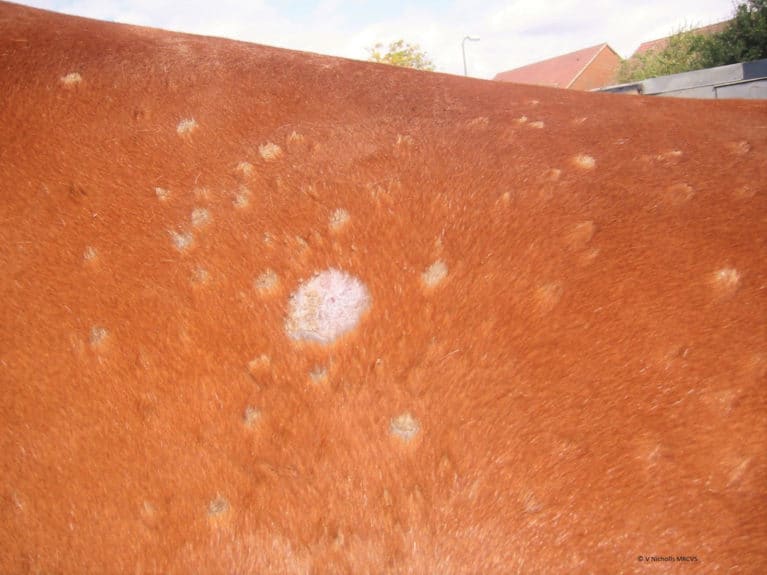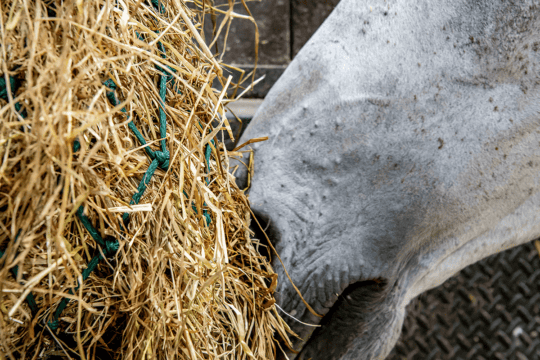Ringworm is the most common fungal skin infection in horses. Vet Poppy Mitchell, from Wensum Valley Vets, explains how to recognise and deal with the problem swiftly to prevent it spreading

Our expert: Poppy Mitchell BSc (Hons) MA VetMB Cert AVP MRCVS is a vet at Wensum Valley Vets, a member of XLEquine. She has a particular interest in equine medicine and dentistry.
Finding a single tuft of raised hairs sticking up from your horse’s coat may not cause much concern at first – maybe he’s caught himself in the field or has been bitten by a fly? But when several more tufts appear and there’s no obvious cause, what could be responsible and should you be worried?
One of the possible causes is ringworm, a highly contagious fungal skin disease. A fungus is a type of organism that breaks down and feeds on the substance it lives on, and produces reproductive spores that enable it to spread easily. The fungus responsible for most cases of equine ringworm is Trichophyton equinum, which is particularly adapted to horses. Rapid diagnosis and treatment are essential in order to prevent further spread, which can occur very quickly.
How does ringworm spread?
Ringworm spreads by transfer of infected hair and skin, or parts of the fungus, from an infected horse onto another. This can occur by…
- direct transfer, which is transfer of infection from one horse to another by touching or mutual grooming.
- indirect transfer, which is transfer of infection into the environment – for example, onto stabling, fencing, floors, grooming kits, tack and rugs. When horses come into contact with objects carrying the fungus, they can become infected.
The reproductive spores produced by the ringworm fungus can survive for long periods of time, so cases can arise months to years after the initial case has been treated. People handling infected horses are often responsible for indirect transfer between horses.
The health of the horse is influential on whether a ringworm infection develops when he comes into contact with the fungus. Youngsters, elderly horses and those with immunosuppression due to medication or disease are at increased risk due to lower immunity levels. Horses with damage to the surface of their skin – for example, fly bites, or rubs from tack or rugs – may also be more prone, as broken skin aids establishment of the infection.
What to look for
The first signs of ringworm become evident from six days to six weeks after contact with the infection – this is called the incubation period. The number of ringworm patches vary from one to many, depending on the horse, and are often seen on areas subject to local trauma, such as rubs from tack, rugs and riders’ boots.
Usually, circular tufts of hair 1–2cm in diameter are seen standing up against the lie of the horse’s coat, sometimes surrounded by a raised ring. If you look closely, you’ll often see a cigarette ash-like deposit between the hairs. After approximately six days, the hairs can be easily plucked away, leaving silvery, scaly skin beneath. Later, as the healing process is underway, new hairs grow within the centre of the hairless circles, giving the classic ringworm appearance.
Less commonly, a horse with ringworm may present with generally scaly skin and irregular hairless patches. It is uncommon for horses to be severely itchy or in pain when they have a simple ringworm infection, but mild irritation or reddening around the scaly patch may be seen.
If you spot changes to your horse’s coat and you know that he’s been in direct or indirect contact with ringworm infection within the previous six weeks, then it’s likely that this is the problem.
You should be suspicious if your horse…
- has recently shared transport, stabling or tack with another horse
- has been to a show or event and touched other horses
- is young or elderly
- is immunosuppressed due to medical treatment or an underlying condition such as PPID (Cushing’s disease)
Did you know?
Ringworm can have major economic consequences, as outbreaks can result in yards being shut down, where horses are banned from moving on or off the premises. Horses with active ringworm lesions are banned from UK racecourses and affiliated competitions.
Confirming the cause
Contact with your vet is essential as soon as you’re suspicious that you may be dealing with ringworm, as treatment and decontamination need to be started as soon as possible to minimise the risk of spread. In all cases, a detailed history and physical examination are necessary. A diagnosis of ringworm may not be possible based on the appearance of the skin alone, so laboratory testing should be performed. There are three options…
1. Culture (growth) of the ringworm fungus from tufts of hair, scab, scale or skin scrapings is the most reliable test. Further tests can then be performed to identify the specific fungus causing the infection. Results can take up to two weeks, so additional samples and skin scrapings are often submitted to the laboratory at the same time for different tests to get a quicker result.
2. Examination of tufts of hair, scab, skin scale or scrapings under a microscope may identify parts of the fungus or fungal spores. Results can be available within 48 hours.
3. Skin biopsy (taking a small piece of skin to examine under a microscope) is not as sensitive as fungal culture, however, it’s sometimes used in more complicated cases when results of the culture are questioned. The presence of fungal elements within the biopsy sample is proof of infection.
Treatment and management of ringworm
Although ringworm infections in healthy horses tend to resolve without treatment within six to eight weeks, every confirmed case of ringworm should receive treatment because it shortens the infection time and helps to protect other horses.
The aims of treatment are to…
- reduce the severity and duration of the infection via the application of fungicidal medication
- maximise the horse’s ability to fight off the infection – stop immunosuppressive medications, correct nutritional imbalances and treat any additional diseases that the horse is suffering from
- minimise direct spread of the infection by isolating the horse
- minimise contamination of the environment and, therefore, indirect spread of the disease
Affected horses are usually treated with antifungal creams, shampoos or washes that are applied to the skin. Creams tend to be used when only a few skin lesions are present, while shampoos and washes are advised when there is more generalised infection of the skin. The frequency and method of application varies considerably between the products and you should follow the advice of your vet.
A licensed oral treatment for ringworm is also available, containing the active ingredient griseofulvin. However, it’s important that this isn’t given to pregnant mares or handled by pregnant women.
It’s also important to remember that ringworm is a zoonosis – an animal disease that can infect humans – so bear this in mind when handling affected horses and anything they’ve been in contact with. Disposable gloves and washable overalls should be worn while treating your horse to minimise the risk of contracting ringworm or spreading it further.
Did you know?
Occasionally infection can occur after contact with animals such as cattle, sheep, cats and dogs infected with other species of fungus.
Minimising the spread
As soon as you’re suspicious you have a case of ringworm on your yard, take preventative measures to try to avoid further cases arising. Unfortunately, due to the long incubation period and the survival of fungal spores within the environment for long periods of time, additional cases are commonly seen. All horses on the premises should be closely monitored for the appearance of skin lesions.
The steps you can take to prevent spread include…
- isolating the infected horse, ideally in a stable that can be easily cleaned after it has been vacated. Organise a separate grooming kit, set of rugs and mucking out utensils to be kept with the horse. Wear disposable gloves and barrier clothing, and organise hand sanitiser and a bucket of disinfectant to dip your boots into when leaving his stable
- stopping all horse movements on and off the yard until you can be certain no further cases are likely – this means waiting at least six weeks after the appearance of the last case
- allowing only essential visitors onto the yard
- starting a clean-up operation. Unfortunately, it’s impossible to destroy every fungal spore in the environment, but a big clean-up is the most effective way of reducing the quantity. Burn or immediately bag and dispose of all used bedding. Disinfect or steam-clean all surfaces, including stables, field shelters, fencing, floors and transport. Avoid using pressure washers set at greater than 120psi, as they can produce aerosols that spread the spores through the air rather than washing them away. Disinfect or dispose of grooming kits, rugs and other items that have been in contact with the horse.
The after effects
Horses suffering from ringworm tend to clear the condition with no adverse effects. It’s possible for reinfection to occur during an outbreak, but the severity is reduced if it’s caused by the same fungus as the previous infection. This is most common in larger yards with infections that circulate among the horses and a huge number of fungal spores in the environment.
Prevent and protect
There are several things you can do to help prevent ringworm becoming established on your yard…
- isolate new horses on your yard for at least six weeks
- when out and about, don’t allow contact between your horse and others
- keep separate grooming kits and tack for each horse or at least regularly disinfect all grooming brushes, clean tack and wash numnahs
- disinfect unknown stables and transport prior to use
- ensure you thoroughly wash your hands after contact with horses you don’t know. Not only will this minimise the risk of you passing the infection on to your horse, but also of you contracting it yourself
Did you know?
Cases of ringworm are seen at all times of the year, but are more common in the autumn and winter when horses are stabled and are in closer proximity to each other.
Stop ringworm in its tracks
Although the infection will get better without treatment and doesn’t leave affected horses with lasting damage, once an outbreak of ringworm occurs it’s so contagious that it can be very difficult and time-consuming to resolve. Plus, it’s incredibly expensive if it results in businesses shutting down. So while it can feel like an effort to take measures to prevent an outbreak, it’s well worth doing.











